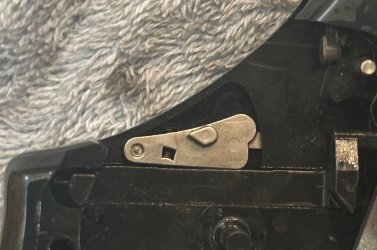OK, I decided to go ahead and open her back up and show you what's there. My memory failed me; it does still have the "lug" on the little "flag" plate, but it cannot engage the hammer notch, so...why? As you can see, it's not the same part as the "flag" in the IL models, and there is no engagement cam either. It also doesn't have the same retention method with the little fork as the IL system uses. It has some kind of pivoting arm with spring for retention. The spring holds this part in downward orientation so that it cannot pivot upward to engage the hammer. I also included a pic of the hammer so you can see it is the same hammer used in the IL models. So this begs the question... why did S&W decide to make an entirely new part and bother putting this part in the no-lock guns to begin with? I'm sure it is a transition part if they are eventually planning to move away from the locks. But still, it has no apparent function that I can think of, and the gun will still run just fine without it, so why put this thing in there? What is the thought process here?




